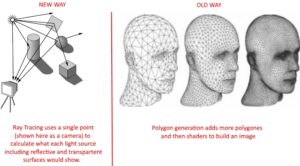What is Ray Tracing:
 Ray Tracing is the newest way for video cards to generate the graphics. Video cards typically draw a thousands or triangles to represent angles and then fill those triangles in with “shaders”. This process is being replaced with Ray Tracing which builds a graphic pixel by pixel by calculating the light rays coming from every light source including reflections.
Ray Tracing is the newest way for video cards to generate the graphics. Video cards typically draw a thousands or triangles to represent angles and then fill those triangles in with “shaders”. This process is being replaced with Ray Tracing which builds a graphic pixel by pixel by calculating the light rays coming from every light source including reflections.
Ray Tracing produces vastly superior images when compared to the old polygon models (triangles and shaders).
There are many Ray Tracing video’s but we find the one below to provide the most clear explanation and demonstrations:
Simplified Ray Tracing Timeline:
- 1500’s – The concept for Ray Tracing was developed in 1500’s by notables like Leonardo da Vinci
- 1968 – First Ray Tracing Algorithm was created by Arthur Appel
- 1978 – Ray Tracing is demonstrated in mini-computers (small mainframes , not to be confused with home PC’s) of the late 1970’s and practical in computer generated graphics
- 2005 – Pixar uses Ray Tracing for the movie Cars. It using Ray Tracing in everything notable since
- 2018 Oct – nVidia releases consumer grade video cards (GeForce RTX-20 series) that support Ray Tracing for home computers
Ray Tracing vs DXR vs RTX:
RTX stands for Ray Tracing (generic) and DXR stands for DirectX Ray Tracing (Microsoft).
Ray Tracing in 2019:
As of March 2019 there are only a few products (ok… games) that take advantage of Ray Tracing but the hope is that Ray Tracing will be used by everything from video rendering to Windows GUI.
This initial release of nVideo GeForce RTX-20 video cards had problematic drivers that caused games that supported Ray Tracing to perform much worse than their old-school polygon generated competition. It has been reported that an update to those drivers resulted in a massive improvement.
AMD says that Ray Tracing is important and it will get consumer product released likely in 2019, but has not provided dates or product details.
 Companies like Pixar that use Ray Tracing for movies can (and do) take many hours to render each frame of a film because there software is considering nearly every light source and reflection. Toy Story 3 took nearly 1100 days to produce and that was at 30 frames per second; not exactly first person shooter game speed. Consumer grade real time Ray Tracing has been made possible by a massive increase in GPU speed in recent years and chip builders intentionally reducing the number of light sources they consider.
Companies like Pixar that use Ray Tracing for movies can (and do) take many hours to render each frame of a film because there software is considering nearly every light source and reflection. Toy Story 3 took nearly 1100 days to produce and that was at 30 frames per second; not exactly first person shooter game speed. Consumer grade real time Ray Tracing has been made possible by a massive increase in GPU speed in recent years and chip builders intentionally reducing the number of light sources they consider.
Look at the image to the right which was produced by off-line Ray Tracing (no it is not a photo… it is completely CG) and you can count hundred of light sources. If this was produced by a real-time game, it would look great but but not this good as it would not show as many reflections and refractions.
Today these games support Ray Tracing.
- Assetto Corsa Competizione
- Atomic Heart
- Battlefield V
- Control
- Enlisted
- Justice
- JX3
- MechWarrior 5: Mercenaries
- Metro Exodus
- ProjectDH
- Shadow of the Tomb Raider



3 Comments
Xampy · October 29, 2020 at 5:29 am
Hi Ian, one correction: Assetto Corsa Competizione cancelled their plans for ray tracing support long ago. The game never had it and probably never will.
Bitron · September 5, 2020 at 12:20 am
WRONG.
Ray Tracing itself is as old as computer graphics. It was one of the first techniques used to make 3D graphics. Especially 3D animated movies have always been ray traced. It is just very resource intensive and hasn’t been a viable option for real time graphic applications.
Also, RTX is NOT generic Ray Tracing. RTX how nVidia in particular markets their new technologies surrounding their RTX graphics cards. Which includes their specific implementation of ray tracing, but also DLSS and other things.
Ian Matthews · September 18, 2020 at 9:17 am
Hi Briton;
Thanks for the clarifications.